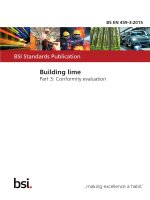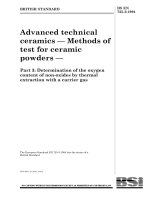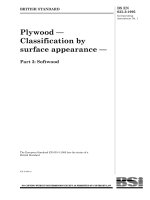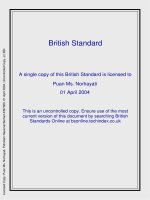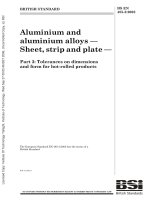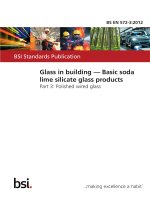Bsi bs en 61300 3 15 1997 (2000)
Bạn đang xem bản rút gọn của tài liệu. Xem và tải ngay bản đầy đủ của tài liệu tại đây (381.94 KB, 12 trang )
BRITISH STANDARD
Fibre optic
interconnecting
devices and passive
components —
Basic test and
measurement
procedures —
Part 3.15: Examinations and
measurements — Eccentricity of a
convex polished ferrule endface
The European Standard EN 61300-3-15:1997 has the status of a
British Standard
ICS 33.180.20
BS EN
61300-3-15:
1997
IEC 61300-3-15:
1995
BS EN 61300-3-15:1997
National foreword
This British Standard is the English language version of EN 61300-3-15:1997.
It is identical with IEC 61300-3-15:1995.
The UK participation in its preparation was entrusted by Technical Committee
EPL/86, Fibre optics, to Subcommittee EPL/86/2, Interconnecting devices and
passive components, which has the responsibility to:
— aid enquirers to understand the text;
— present to the responsible international/European committee any
enquiries on the interpretation, or proposals for change, and keep the UK
interests informed;
— monitor related international and European developments and
promulgate them in the UK.
A list of organizations represented on this subcommittee can be obtained on
request to its secretary.
From 1 January 1997, all IEC publications have the number 60000 added to
the old number. For instance, IEC 27-1 has been renumbered as IEC 60027-1.
For a period of time during the change over from one numbering system to the
other, publications may contain identifiers from both systems.
Cross-references
Attention is drawn to the fact that CEN and CENELEC Standards normally
include an annex which lists normative references to international
publications with their corresponding European publications. The British
Standards which implement these international or European publications may
be found in the BSI Standards Catalogue under the section entitled
“International Standards Correspondence Index”, or by using the “Find”
facility of the BSI Standards Electronic Catalogue.
A British Standard does not purport to include all the necessary provisions of
a contract. Users of British Standards are responsible for their correct
application.
Compliance with a British Standard does not of itself confer immunity
from legal obligations.
Summary of pages
This document comprises a front cover, an inside front cover, pages i and ii,
the EN title page, pages 2 to 7 and a back cover.
This standard has been updated (see copyright date) and may have had
amendments incorporated. This will be indicated in the amendment table on
the inside front cover.
This British Standard, having
been prepared under the
direction of the Electrotechnical
Sector Board, was published
under the authority of the
Standards Board and comes
into effect on
15 November 1997
© BSI 04-2000
ISBN 0 580 28507 3
Amendments issued since publication
Amd. No.
Date
Comments
BS EN 61300-3-15:1997
Contents
National foreword
Foreword
Text of EN 61300-3-15
© BSI 04-2000
Page
Inside front cover
2
3
i
ii
blank
EUROPEAN STANDARD
EN 61300-3-15
NORME EUROPÉENNE
August 1997
EUROPÄISCHE NORM
ICS 33.180.20
English version
Fibre optic interconnecting devices and passive
components
Basic test and measurement procedures
Part 3-15: Examinations and measurements
Eccentricity of a convex polished ferrule endface
(IEC 61300-3-15:1995)
Dispositifs d’interconnexion et composants
passifs à fibres optiques Méthodes
fondamentales d’essais et de mesures
Partie 3-15: Examens et mesures Excentricité
de la face terminale d’un embout poli convexe
(CEI 61300-3-15:1995)
Lichtwellenleiter — Verbindungselemente und
passive Bauteile — Grundlegende Prüf- und
Meßverfahren
Teil 3-15: Untersuchungen und Messungen —
Exzentrizität eines konvex polierten Stiftes
(IEC 61300-3-15:1995)
www.bzfxw.com
This European Standard was approved by CENELEC on 1997-07-01.
CENELEC members are bound to comply with the CEN/CENELEC Internal
Regulations which stipulate the conditions for giving this European Standard
the status of a national standard without any alteration.
Up-to-date lists and bibliographical references concerning such national
standards may be obtained on application to the Central Secretariat or to any
CENELEC member.
This European Standard exists in three official versions (English, French,
German). A version in any other language made by translation under the
responsibility of a CENELEC member into its own language and notified to the
Central Secretariat has the same status as the official versions.
CENELEC members are the national electrotechnical committees of Austria,
Belgium, Denmark, Finland, France, Germany, Greece, Iceland, Ireland, Italy,
Luxembourg, Netherlands, Norway, Portugal, Spain, Sweden, Switzerland and
United Kingdom.
CENELEC
European Committee for Electrotechnical Standardization
Comité Européen de Normalisation Electrotechnique
Europäisches Komitee für Elektrotechnische Normung
Central Secretariat: rue de Stassart 35, B-1050 Brussels
© 1997 CENELEC — All rights of exploitation in any form and by any means reserved worldwide for
CENELEC members.
Ref. No. EN 61300-3-15:1997 E
EN 61300-3-15:1997
Foreword
The text of the International Standard
IEC 61300-3-15:1995, prepared by SC 86B, Fibre
optic interconnecting devices and passive
components, of IEC TC 86, Fibre optics, was
submitted to the formal vote and was approved
by CENELEC as EN 61300-3-15
on 1997-07-01 without any modification.
The following dates were fixed:
— latest date by which the EN
has to be implemented at
national level by
publication of an identical
national standard or by
endorsement
(dop) 1998-06-01
— latest date by which the
national standards
conflicting with the EN
have to be withdrawn
(dow) 1998-06-01
Contents
Foreword
1
General
1.1 Scope and object
1.2 General description
1.3 Normative reference
2
Apparatus
3
Procedure
4
Details to be specified
Figure 1 — Definition of dome eccentricity
Figure 2 — Example of set-up for eccentricity
measurement (method 1)
Figure 3 — Example of displacement of
ring centre for ferrule rotation
Figure 4 — Example of set-up for eccentricity
measurement (method 2)
Page
2
3
3
3
4
4
4
4
3
5
6
7
Endorsement notice
The text of the International Standard
IEC 61300-3-15:1995 was approved by CENELEC
as a European Standard without any modification.
2
www.bzfxw.com
© BSI 04-2000
EN 61300-3-15:1997
1 General
1.1 Scope and object
The object of this part of IEC 1300 is to describe
measurements of dome eccentricity of a spherically
polished ferrule endface. Two procedures are
presented: a Newton ring method and an
interference method.
1.2 General description
Dome eccentricity (X) is defined as the distance
between the axis of the ferrule and the line parallel
to the axis which passes through the vertex or
highest point on the dome formed by spherically
polishing the ferrule as shown in Figure 1.
The eccentricity may be directly determined as the
distance between the centre of the fibre or fibre hole
and the centre of the Newton ring or interference
ring. In this case, the eccentricity measurement will
be affected by any misalignment of the measuring
system, especially the angular offset between the
ferrule axis and the interferometric axis. The
alignment of the measuring system shall be strictly
checked and adjusted.
In both the Newton ring method and an interference
method, errors due to misalignment of the
measuring system can be reduced by rotating the
ferrule around its axis and observing the maximum
displacement of the centre of the Newton or
interference rings. The dome eccentricity is one-half
of the maximum displacement.
1.2.1 Method 1 — Newton ring method
(contacting method)
In this method, the polished ferrule is pressed
against a flat glass plate which is held
perpendicular to the axis of the ferrule, and by using
a microscope the Newton ring is observed. The
ferrule is rotated around its axis. The displacement
of the centre of the Newton ring is observed. The
eccentricity is determined as one-half of the
maximum displacement.
1.2.2 Method 2 — Interference ring method
(non-contacting method)
This method uses an interferometer and a
microscope with a TV camera.
Interference is created between the reference beam
and the beam reflected from the ferrule endface, and
the interference ring is observed. The ferrule is
rotated around its axis. The displacement of the
centre of the interference ring is observed. The
eccentricity is determined as one-half of the
maximum displacement.
www.bzfxw.com
Figure 1 — Definition of dome eccentricity
© BSI 04-2000
3
EN 61300-3-15:1997
1.3 Normative reference
3 Procedure
The following normative document contains
provisions which, through reference in this text,
constitute provisions of this part of IEC 1300. At the
time of publication, the edition indicated was valid.
All normative documents are subject to revision,
and parties to agreements based on this part of
IEC 1300 are encouraged to investigate the
possibility of applying the most recent edition of the
normative document indicated below. Members of
IEC and ISO maintain registers of currently valid
International Standards.
ISO 2538:1974, Limits and fits — Series of angles
and slopes on wedges and prisms
3.1 Method 1 — Newton ring method
2 Apparatus
2.1 Method 1 — Newton ring method
This method 1 requires the following material:
— a ferrule holder with a V-groove or precision
sleeve mounted on a micro-manipulator (the
ferrule holder shall be capable of holding the
ferrule against the glass plate with a specified
force. According to ISO 2538, the preferred angle
for the V-groove is 108°);
— a flat glass plate perpendicular to the axis of
the V-groove or precision sleeve;
— a microscope;
— a light source (white light).
2.2 Method 2 — Interference ring method
This method 2 requires the following material:
— a V-groove or precision sleeve mounted on a
micro-manipulator (according to ISO 2538, the
preferred angle for the V-groove is 108°);
— an interferometer;
— a microscope with TV camera;
— a TV monitor;
— a light source (example: He-Ne laser,
monochromatic lamp).
4
a) Place the ferrule in the V-groove or the
precision sleeve.
b) Position the ferrule into a visual field of the
microscope using the micro-manipulator.
c) Bring the ferrule into perpendicular contact
with the glass plate and with the specified
pressure at the ferrule/glass interface.
d) Observe the Newton ring and record the
position of the centre of the ring (see Figure 2).
e) Rotate the ferrule through 180°. Record the
second position of the centre of the ring.
f) Record the displacement 2X of the centre of the
Newton ring. The dome eccentricity is one-half of
the displacement [see Figure 3 a) and
Figure 3 b)].
3.2 Method 2 — Interference ring method
a) Place the ferrule in the V-groove or the
precision sleeve.
b) Position the ferrule into a visual field of the TV
screen using the micro-manipulator.
c) Observe the interference ring and record the
position of the centre of the ring (see Figure 4).
d) Rotate the ferrule through 180°. Record the
second position of the centre of the ring.
e) Record the displacement 2X of the centre of
the interference ring. The dome eccentricity is
one-half of the maximum displacement
[also see Figure 3 a) and Figure 3 b)].
www.bzfxw.com
NOTE In both methods, the eccentricity may be determined by
recording three or more positions of the ring centre on its circle
locus as the ferrule is rotated and by calculating the radius of the
least squares circle.
4 Details to be specified
The following details, as applicable, shall be
specified in the detail specification:
— magnification on microscope;
— maximum allowable repeatability of
measuring system;
— allowable dome eccentricity.
© BSI 04-2000
EN 61300-3-15:1997
www.bzfxw.com
Figure 2 — Example of set-up for eccentricity measurement (method 1)
© BSI 04-2000
5
EN 61300-3-15:1997
Figure 3 a) — Ideal measurement when the measuring system has no misalignment
www.bzfxw.com
Figure 3 b) — Actual measurement when the measuring system has any angular offset
Figure 3 — Example of displacement of ring centre for ferrule rotation
6
© BSI 04-2000
EN 61300-3-15:1997
www.bzfxw.com
Figure 4 — Example of set-up for eccentricity measurement (method 2)
© BSI 04-2000
7
BS EN
61300-3-15:
1997
IEC 61300-3-15:
1995
BSI — British Standards Institution
BSI is the independent national body responsible for preparing
British Standards. It presents the UK view on standards in Europe and at the
international level. It is incorporated by Royal Charter.
Revisions
British Standards are updated by amendment or revision. Users of
British Standards should make sure that they possess the latest amendments or
editions.
It is the constant aim of BSI to improve the quality of our products and services.
We would be grateful if anyone finding an inaccuracy or ambiguity while using
this British Standard would inform the Secretary of the technical committee
responsible, the identity of which can be found on the inside front cover.
Tel: 020 8996 9000. Fax: 020 8996 7400.
BSI offers members an individual updating service called PLUS which ensures
that subscribers automatically receive the latest editions of standards.
Buying standards
Orders for all BSI, international and foreign standards publications should be
addressed to Customer Services. Tel: 020 8996 9001. Fax: 020 8996 7001.
In response to orders for international standards, it is BSI policy to supply the
BSI implementation of those that have been published as British Standards,
unless otherwise requested.
Information on standards
www.bzfxw.com
BSI provides a wide range of information on national, European and
international standards through its Library and its Technical Help to Exporters
Service. Various BSI electronic information services are also available which give
details on all its products and services. Contact the Information Centre.
Tel: 020 8996 7111. Fax: 020 8996 7048.
Subscribing members of BSI are kept up to date with standards developments
and receive substantial discounts on the purchase price of standards. For details
of these and other benefits contact Membership Administration.
Tel: 020 8996 7002. Fax: 020 8996 7001.
Copyright
Copyright subsists in all BSI publications. BSI also holds the copyright, in the
UK, of the publications of the international standardization bodies. Except as
permitted under the Copyright, Designs and Patents Act 1988 no extract may be
reproduced, stored in a retrieval system or transmitted in any form or by any
means – electronic, photocopying, recording or otherwise – without prior written
permission from BSI.
This does not preclude the free use, in the course of implementing the standard,
of necessary details such as symbols, and size, type or grade designations. If these
details are to be used for any other purpose than implementation then the prior
written permission of BSI must be obtained.
BSI
389 Chiswick High Road
London
W4 4AL
If permission is granted, the terms may include royalty payments or a licensing
agreement. Details and advice can be obtained from the Copyright Manager.
Tel: 020 8996 7070.

